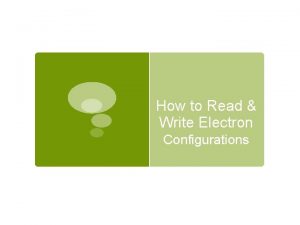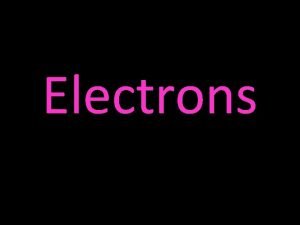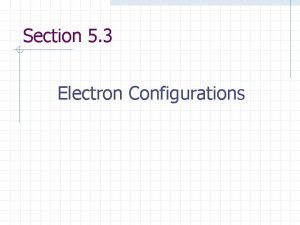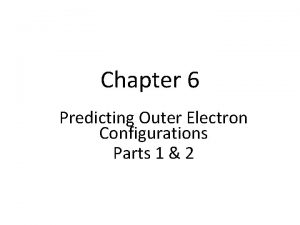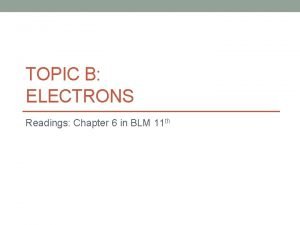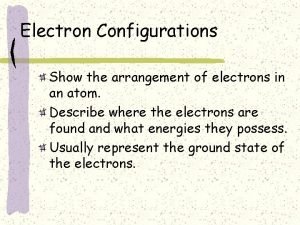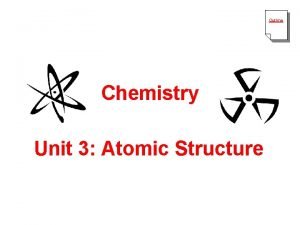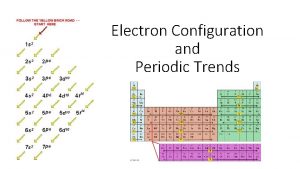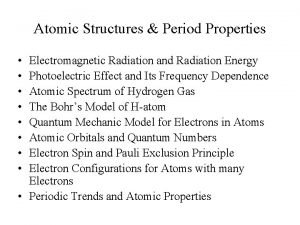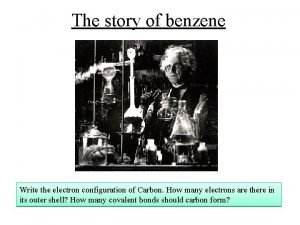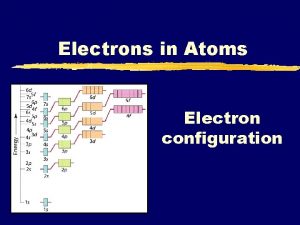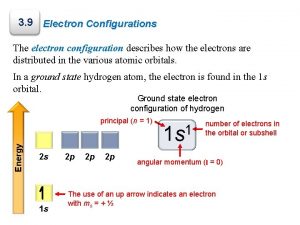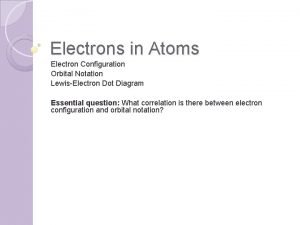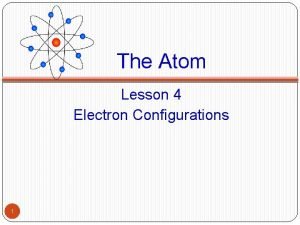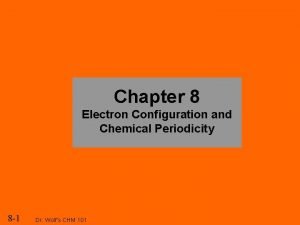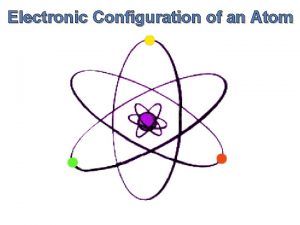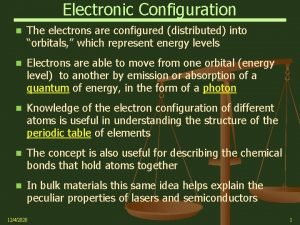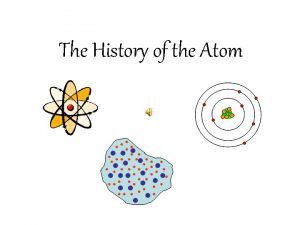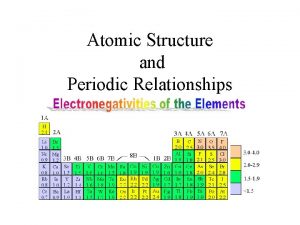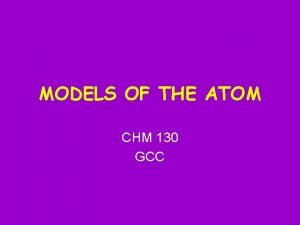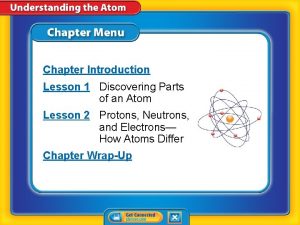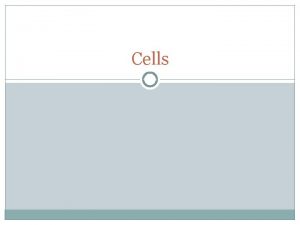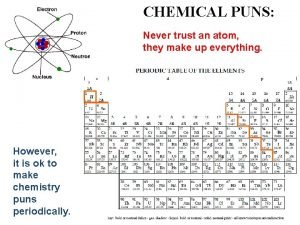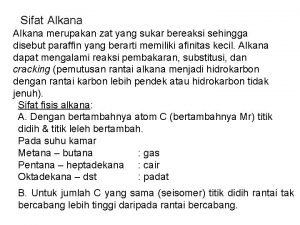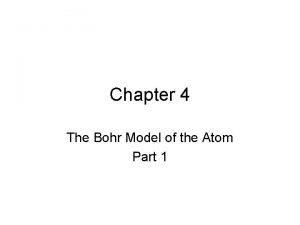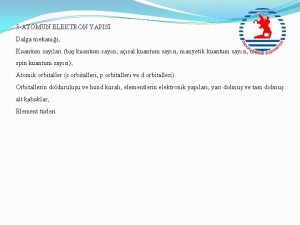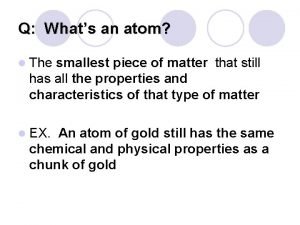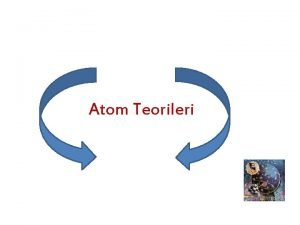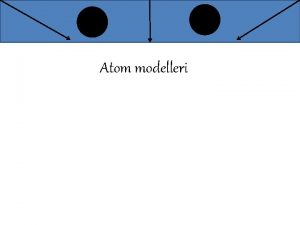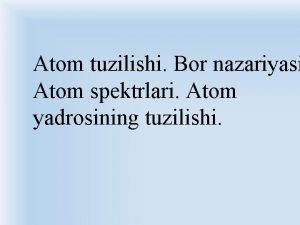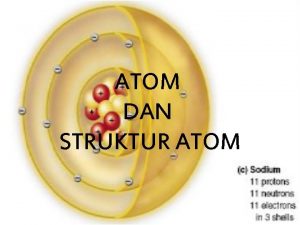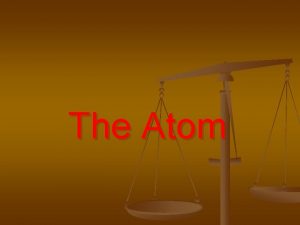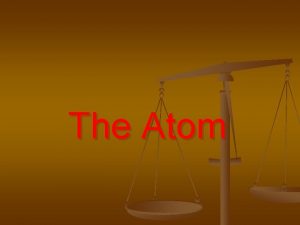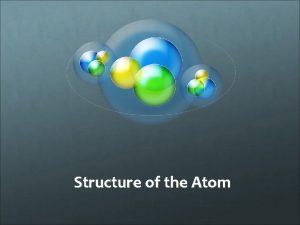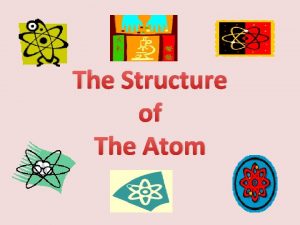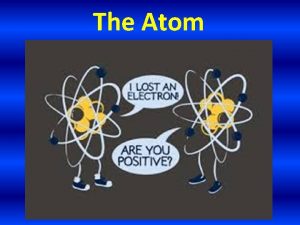Electronic Configuration of an Atom Electronic Configuration of


























































- Slides: 58

Electronic Configuration of an Atom

Electronic Configuration of an Atom Electrons spin around the nucleus of the atom in a series of levels known as energy shells. The electrons are grouped together in a specific arrangement. We can represent the arrangement of electrons in an atom, known as the electronic configuration, using the scientific model.

Model of the Arrangement of Electrons in an Atom

In this scientific model, the energy shells are drawn as concentric circles around the nucleus, but as this is only a model, this in not how they actually look. The shells are numbered according to their distance from the nucleus. The shell closest to the nucleus is assigned number 1, the next furthest, number 2 etc. Each shell can hold a certain maximum number of electrons. The maximum number of electrons that an energy shell can hold is given by the formula 2 n 2 where n is the shell number.

Maximum Number of Electrons in Each Shell Electron Shell Number (n) Maximum Number of Electrons (2 n 2) 1 2 2 8 3 18 (8 then 10) 4 32

The electrons are constantly being attracted to the positive nucleus by an electrostatic force of attraction. They maintain their spin around, and distance from, the nucleus because of the energy they possess. Electrons in a lower shell (closer to the nucleus) have less energy than those in a higher shell (further from the nucleus). In fact, electrons can only occupy a specific shell if they have the required energy.

Electronic Configuration The electronic configuration (or structure) of an atom of an element can be represented by drawing a shell diagram, or in writing using numbers. When drawing the electronic configuration of an atom using a shell diagram, there are certain rules that must be followed.

Rules for Drawing Electronic Configuration 1. First you need to know the number of electrons in the atom of the element. This is the same as the number of protons or the atomic number. 2. Electrons will always fill up the shells in order, i. e. electrons fill up shell 1 and when that is full, they start filling up shell 2 and so on.

3. There is something unusual that occurs in shell number 3. When 8 electrons have been placed in shell number 3, the next 2 electrons are placed in shell number 4. Only after these 2 electrons have been placed in shell number 4 are the remaining 10 electrons placed in shell number 3. 4. To represent the electronic configuration, concentric circles are drawn around a central point (the nucleus of the atom). Crosses or dots are used to represent the electrons in the shells. The number of concentric circles is determined by the number of shells that are going to be filled (or partially filled).

Example: What is the electronic configuration of potassium? Answer: Potassium has 19 electrons. Shell Number (n) Max number of electrons (2 n 2) Number of electrons in potassium 1 2 2 2 8 8 3 18 (8 then 10) 8 4 32 1 When writing the electronic configuration, the symbol of the element is written first, followed by the number of electrons in each shell separated by commas. For potassium it would be K (2, 8, 8, 1)

Example: Draw the electronic configuration of potassium. Answer: The electronic configuration of potassium is K (2, 8, 8, 1). This is drawn as shown below:

Questions: Represent the electronic configuration of the following atoms using both a shell diagram and writing: 1. Hydrogen 2. Boron 3. Oxygen 4. Sodium 5. Argon 6. Calcium

Answers

Valence Electrons The electrons in the outermost energy shell are known as the valence electrons. For example, potassium, K (2, 8, 8, 1), has 1 valence electron. The outermost electrons are involved in chemical reactions, i. e. the valence electrons.

Question: Name the element depicted below and state the number of valence electrons for this element. Answer: The element is carbon and it has 4 valence electrons.

Valence Electrons A diagram of an atom can also be drawn which only shows the valence electrons. Examples of these are given in the diagram below.

Structure & Bonding

Recap of Atomic Structure Activity: Fill in the blanks to recap your knowledge of atomic structure. Atoms have a central nucleus surrounded by _____. The electrons around the nucleus are arranged in _____. The electron configuration is the number of _____in each occupied shell. For example, an atom of _______ contains 11 electrons and the electron configuration of the _______ atom is 2. 8. 1. An atom with a full outermost electron shell is an atom of a ____ gas, such as helium, argon or neon.

Answers Atoms have a central nucleus surrounded by electrons. The electrons around the nucleus are arranged in shells. The electron configuration is the number of electrons in each occupied shell. For example, an atom of sodium contains 11 electrons and the electron configuration of the sodium atom is 2. 8. 1. An atom with a full outermost electron shell is an atom of a noble gas, such as helium, argon or neon.

Stable Electronic Structures

Stable Electronic Structures Activity: Look at your copy of the Periodic Table.

Stable Electronic Structures What happens to the number of electrons in the outer shell as you move from left to right across a period? It increases across a period until the shell becomes full at the right-hand end of the period. What is the name of the group of elements with full outer shells? The noble gases. Scientists have found that the noble gases are very unreactive. What does this tell you about a full outer shell of electrons? It provides stability; therefore, atoms of elements in other groups may also seek to attain a full outer shell of electrons.

Stable Electronic Structures Noble gases exist as single atoms because the full outer shell makes each atom stable.

Stable Electronic Structures Atoms of other elements do not have full outer shells. Examples: Sodium 2, 8, 1 Chlorine 2, 8, 7 What would atoms of these other elements have to do to achieve a full outer shell?

Stable Electronic Structures Atoms gain stability if they obtain the noble gas configuration of the nearest noble gas to them in the periodic table.

Stable Electronic Structures Example 1: What is the nearest noble gas to sodium? What would sodium have to do in order to attain the electronic configuration of neon?

Stable Electronic Structures Example 2: What is the nearest noble gas to chlorine? What would chlorine have to do in order to attain the electronic configuration of argon?

Stable Electronic Structures Atoms can obtain the noble gas configuration of the nearest noble gas to them in the periodic table during the following chemical changes. They can: 1. donate one or more electrons to another atom 2. gain one or more electrons from another atom 3. share electrons with another atom

Stable Electronic Structures This chemical change is known as chemical bonding. A chemical bond is an electrostatic force of attraction between two or more atoms or ions. There are three main types of chemical bonding: 1. ionic bonding – formed between metals and nonmetals 2. covalent bonding – formed between two or more nonmetals 3. metallic bonding – formed between metals

Ionic Bonding

Ionic Bonding Ionic bonding is a transfer of valence electrons between metal and non-metal atoms. Usually the transfer is from the metal atom to the nonmetal atom.

Ionic Bonding Metals lie to the left of the periodic table; if they lose electrons they can attain noble gas configuration. Non-metals lie to the right of the periodic table; if they gain electrons they can attain noble gas configuration.

Ionic Bonding When an atom loses or gains electrons it forms an ion. The ions formed are now charged particles because they no longer contain the same number of protons and electrons.

Cations & Anions

Cations & Anions When a metal atom loses electrons it forms a positive ion called a cation. When a nonmetal atom gains electrons it forms a negative ion called an anion.

Losing & Gaining Electrons

Losing Electrons – Group 1 One way to obtain a full outer orbital is to lose electrons from a partially filled orbital. Atoms of elements in Group 1, and hydrogen, have a single electron in their outer orbital. If this electron is lost then the full orbital beneath now becomes the full outer orbital.

Losing Electrons Example: Sodium The chemical reaction is: Na → Na+ + e. An electron configuration of 2. 8. 1 becomes 2. 8.

Losing Electrons In an atom the number of electrons in the orbitals is equal to the number of protons in the nucleus. If one electron is removed this leaves a net charge of +1; a sodium atom has become a sodium ion.

Losing Electrons – Group 2 Similarly Group 2 elements have two electrons in their outer orbital. Example: Magnesium 2+ Mg → Mg 2++2 e. An electron configuration of 2. 8. 2 becomes 2. 8. As the magnesium atom has lost two electrons, the magnesium ion carries a charge of +2.

Losing Electrons – Group 3 It is possible for aluminium to produce the aluminium ion, Al 3+, by losing three electrons. Activity: Draw the electronic configuration of the aluminium atom and the electronic configuration of the aluminium ion. Beyond this, it requires too much energy to remove four or more electrons so the elements from Group 4 and onwards do not form positively charged ions.

Gaining Electrons As well as losing electrons, it is possible to obtain a full outer orbital by gaining electrons.

Gaining Electrons – Group 7 Atoms of the elements in Group 7 have seven electrons in their outer orbital. They can attain a full outer orbital by gaining one more electron: Cl + e- → Cl. An electron configuration of 2. 8. 7 becomes 2. 8. 8.

Gaining Electrons – Group 6 elements need two electrons to attain a full outer orbital: O + 2 e- → O 2 An electron configuration of 2. 6 becomes 2. 8.

Gaining Electrons – Group 5 It is possible for phosphorus to produce the phosphide ion, P 3 -, by gaining three electrons. Activity: Draw the electronic configuration of the phosphorous atom and the electronic configuration of the phosphide ion. Beyond this, gaining four or more electrons would make an atom too unstable so elements up to and including Group 4 do not form negatively charged ions.

Additional Information When an atom forms a negative ion, the name of the ion ends with ‘-ide’, e. g. chloride, bromide, iodide, oxide, sulphide. Also, some groups of two or more atoms combine to form a negative ion, which we see in compounds such as hydroxide, OH-, nitrate, NO 3 -, and sulphate, SO 42 -.

Attraction between Positive & Negative Ions

Attraction between Positive & Negative Ions Positively charged ions and negatively charged ions are attracted to each other and this attraction is the basis of ionic bonding.

Attraction between Positive & Negative Ions In an ionic compound, the number of positive charges must equal the number of negative charges, hence the compound is neutral overall.

Using Shell Diagrams to Represent Ionic Bonding

Example 1: Sodium Chloride Sodium is a metal with one valence electron; therefore it loses this electron to form a positive sodium ion (Na+). Chlorine is a non-metal with seven valence electrons; therefore it gains one electron to form a negative chloride ion (Cl-).

The diagram shows how to use shell diagrams to represent ionic bonding in sodium chloride. Sodium atom Sodium ion (Na+) Chlorine atom Chlorine ion (Cl-)

It is important to note that there is no separate entity such as Na. Cl. Each Na+ ion is immediately surrounded by six Clions and each Cl- ions is immediately surrounded by six Na+ ions.

Na. Cl is referred to as the formula unit or empirical formula of the ionic compound. The ions attract each other forming a highly ordered arrangement known as a crystal lattice. The attraction between each positive cation and each negative anion is known as an ionic bond. Ionic bonds are strong bonds and their strength accounts for some of the properties of ionic compounds.

Example 2: Magnesium Fluoride Magnesium is a metal with two valence electrons; magnesium will lose these two electrons, forming a magnesium ion (Mg 2+). Fluorine is a non-metal with seven valence electrons; fluorine will gain one electron, forming a fluoride ion (F-). For each magnesium atom (that loses two valence electrons) there will need to be two fluorine atoms. Each fluorine atom will accept one electron.

The diagram shows how to use shell diagrams to represent ionic bonding in magnesium fluoride.

Example 3: Aluminium Oxide Aluminium is a metal with three valence electrons; aluminium will lose three electrons, forming an aluminium ion (Al 3+). Oxygen is a non-metal with six valence electrons; oxygen will gain two electrons, forming an oxide ion (O 2 -). Two aluminium atoms will lose six electrons and three oxygen atoms are needed to accept these six electrons therefore the ratio of aluminium to oxygen will be 2: 3.

The diagram shows how to use shell diagrams to represent ionic bonding in aluminium oxide.
 Draw the electronic configuration of magnesium atom
Draw the electronic configuration of magnesium atom Democritus atom modeli
Democritus atom modeli The structure of the atom section 2 defining the atom
The structure of the atom section 2 defining the atom How to read electron configuration
How to read electron configuration Neon atom model
Neon atom model Number of chiral centres in morphine
Number of chiral centres in morphine Electron configuration vs noble gas configuration
Electron configuration vs noble gas configuration Difference between relative and absolute configuration
Difference between relative and absolute configuration Relative configuration
Relative configuration Stable electronic configuration
Stable electronic configuration Chemistry electron configuration
Chemistry electron configuration Define electronic configuration
Define electronic configuration Bai2 file format
Bai2 file format 82pb electron configuration
82pb electron configuration Write the electronic configuration of 24cr and 29cu.
Write the electronic configuration of 24cr and 29cu. Arrangement of electrons
Arrangement of electrons Electron configuration of oxygen
Electron configuration of oxygen Electric configuration
Electric configuration Electronic configuration
Electronic configuration Hund's rule vs aufbau principle
Hund's rule vs aufbau principle Oxygen electron affinity
Oxygen electron affinity Shape of s orbital
Shape of s orbital Pd electron configuration
Pd electron configuration Electron configuration of s
Electron configuration of s Electronic configuration order
Electronic configuration order 12mg electron configuration
12mg electron configuration Dot
Dot Complete ground state electron configuration
Complete ground state electron configuration Pauli exclusion principle
Pauli exclusion principle Electronic configuration
Electronic configuration Electronic configuration of mo (z=42)
Electronic configuration of mo (z=42) Electron configuration 2 8 8 18
Electron configuration 2 8 8 18 5s 25p6 is the outermost electronic configuration of
5s 25p6 is the outermost electronic configuration of 1s1 electron configuration
1s1 electron configuration Electronic news gathering and electronic field production
Electronic news gathering and electronic field production An electronic is the electronic exchange of money or scrip
An electronic is the electronic exchange of money or scrip ü
ü Thomson atom modeli özellikleri
Thomson atom modeli özellikleri Unit 4 atomic structure
Unit 4 atomic structure Know atom
Know atom Periodic trends definition
Periodic trends definition A neutral atom of aluminum 27 contains
A neutral atom of aluminum 27 contains Mg2o
Mg2o Greek for indivisible
Greek for indivisible Dalton atom modeli maketi
Dalton atom modeli maketi Gcc
Gcc John dalton atom modeli
John dalton atom modeli Chapter 7 lesson 1 discovering parts of an atom answer key
Chapter 7 lesson 1 discovering parts of an atom answer key Harker
Harker Atom cell molecule
Atom cell molecule Atom puns
Atom puns Electron cloud
Electron cloud Study of matter
Study of matter Gaya van der waals adalah
Gaya van der waals adalah Atom menurut niels bohr
Atom menurut niels bohr Elektron ilgisi nasıl artar
Elektron ilgisi nasıl artar Atom
Atom Redukujuci disaharid
Redukujuci disaharid Xyv atom
Xyv atom



